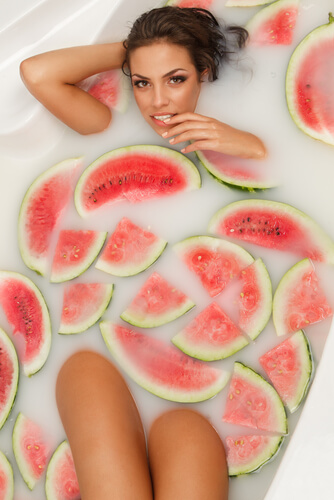
Common household objects and surfaces are dirtier than you think! After many years of swabbing and analyzing over 30 household items in hundreds of different homes, measuring the levels of yeast, mold, coliform bacteria (which includes Salmonella and E. coli) and Staph bacteria, a study from the National Institute of Health found the following locations and items in the average home to harbor most bacteria per square inch:
Think your bathtub is one of the cleanest places in the home? Think again! It actually ranks as the dirtiest and most germ-filled places- at least around the drain where hair collects, soap melts and miscellaneous debris piles up when it clogs up. Bacteria numbers were also very high for other areas in and around the tub, such as the interior shower mat, exterior bathmat, the soap dish that’s usually coated with soap scum and the bathroom floor. 
Spray the entire bathtub with the bathroom cleaner. Use the soft bristled brush to scrub away any build-up and rinse with clean water.
The sponge people use to clean their dishes and counter tops may actually be the dirtiest thing in the home because sponges pick up bacteria while you clean and are often not sanitized before their next use. Seventy-five percent of the tested sponges had coliform prevalent, a bacteria that indicates fecal matter. To disinfect a sponge, soak in water and then heat in microwave for one to two minutes on high, or carefully pour boiling water over it. Microwaving your sponge for two minutes kills 99% of the bacteria living in it.
The abrasions on cutting boards trap moisture and food particles, making these boards an ideal breeding grounds for organisms. Wooden cutting boards are the worst, for they can break down over time and grow coliform in micro tears on the surface and grow mold easier than plastic ones. Clean yours thoroughly after each use with hot water and disinfectant or throw into the dishwasher after use.
Germs multiply in warm places. Between the heat the phones generate and the germs on faces and hands, you've got a bacterial breeding ground. In fact, phones harbor 18 times more bacteria than a flush handle in a typical men's restroom. If you use another person's phone, you can pick their germs and 30% of a virus can make it to your fingertips from a screen. If you rub your eyes, bite your nails, or put your hands to your face otherwise, the virus can get into your system. Add in the lotions, make-up and body oils and you’ve got a real need to clean. Make sure to antibacterial phones between use or every day. Better yet, just wash your hands often with soap and water for at least 20 seconds. 

A 2008 study completed by the Hygiene Council found that 52 percent of kitchen faucets were contaminated with harmful bacteria like E. coli. Sinks are germy due to lingering sponges and improper cleaning methods. Filling the sink with soapy water every time you do dishes is not cleaning it! Research shows that kitchen sinks are actually dirtier than toilet seats! Wash your sink separately, and be sure to follow the instructions on your cleaning supplies. The best solution for cleaning your kitchen sink is to use a bleach-based cleaner. Stainless steel sinks can benefit from a good scrub with a mild soap. Another option is to use white vinegar to sanitize and to remove any stubborn stains or spots. Just make sure to always rinse your sink well after cleaning it, no matter what kind of solution you use.
Pet bowls were the only objects found to be carrying E. coli. Just like sponges, bits of food can get stuck on them, and they are often neglected when it comes to washing. When people keep pet bowls in their kitchen, they are also at risk of introducing more coliform to their kitchen and eating areas. Treat them like your own bowls and wash them regularly.

People spend one third of their lives in their beds. Beds are full of mites, bugs and germs. All the germs people come into contact with that day are climbing in with them, especially if they do not shower before bed. The sweat, skin, and bacteria that accumulate every night can make the bed the perfect spot for more harmful germs to breed. Change sheets once a week. Wash them in hot water with regular detergent. Bleach or a bleach-alternative is another good way to keep them sanitized. Vacuum the mattress regularly, and use a mattress cover. Clean or dry clean the mattress cover quarterly. 
A woman's purse does not only play host to germs such as E.coli and salmonella, it could contain trace amounts of fecal contamination as well. To help keep purses clean, do not put it on the floor of any public place, such as the train, bus, or public restroom. Wipe it down every day with an alcohol-based sanitizer. Avoid using antibacterial products, since these can actually kill good bacteria and make bad bacteria like E. coli more resilient to cleaning solutions. If your purse is machine washable, toss it in the wash every couple of weeks. Using the gentle cycle will help it keep its shape and color. 
Also, give your cell phone and keys a quick clean with a sanitizing wipe so they do not contaminate your purse’s interior with bacteria.
Toothbrushes are usually kept close to the toilet, which sprays fecal matter between 6-10 feet when flushed, and many people forget to wash them. Put toothbrushes in the dishwasher with the rest of your dishes once a week to disinfect them and place them as far away from the commode as possible with a plastic cover. 
Watch out for the refrigerator door handle and microwave buttons. A study, done by scientists at the University of Virginia, found that about 40 percent of the time refrigerator doors and handles as well as microwave buttons were positive for cold germs. Wipe down the door handles and buttons nightly with kitchen cleaner or soap and water. 
Do not forget to antibacterial the light switches and door knobs when routinely cleaning the home. They are some of the most frequently touched surfaces in your home, so make sure you regularly clean them with a disinfectant to prevent the spread of infection.
Scientists found that cold sufferers often leave their germs there, where they can live for two days or longer. In fact, University of Virginia researchers identified the remote as one of the top places to transmit infections in your home. 
According to the National Research Center for Women and Families, studies have found the average desktop has 400 times more bacteria than a toilet bowl. Since most people overlook this area for cleaning, germs that cause the flu and common cold are able to thrive and multiply. In keyboards, dust, crumbs, dirt, and many other items make their way under the keys, leading to a small colony of germs growing beneath the fingertips.
The Centers for Disease Control (CDC) recommends regularly wiping down your desk with a disinfectant. Bleach or alcohol-based cleaners do the trick. Turn the keyboard over and gently tap to free the debris from within the keys or use a keyboard air pressure cleaner (comes in a can).
